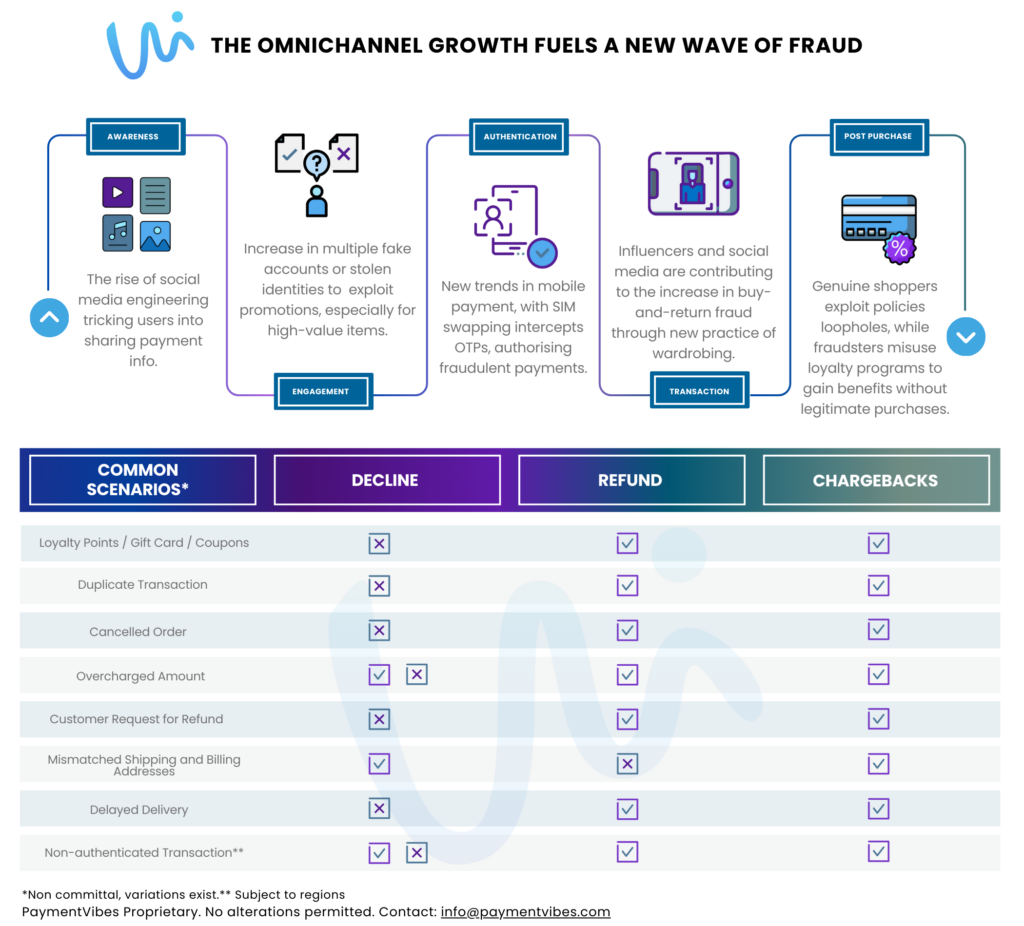The omnichannel revolution has brought unprecedented convenience to shoppers but has also opened a Pandora’s Box of new challenges for retailers, particularly in the context of fraud. While retailers strive to anticipate customer needs and create seamless shopping experiences, fraudsters constantly evolve their tactics, leveraging the very same innovations that enhance the customer journey, to their advantage.

Omnichannel Fraud, Managing a Threat or Embracing an Opportunity?
From the theft of credit card information to the exploitation of return policies, the methods of deception are as varied as the products retailers sell. In my tenure at Richemont, I have witnessed increasingly sophisticated schemes and relentless attacks that caused significant disruptions to the operation I managed. The hidden side of fraud is not just the immediate financial loss, although that is significant in itself, especially when margins are already tight, but fraud drains resources, diverts focus from core business activities, and ultimately impacts the customer experience.
Whilst there is no denying that fraud is a threat with its unique sets of challenges, in my view, fraud also offers a chance to reimagine security as it forces retailers to rethink their approaches from reactively fighting fraud to proactively propelling their infrastructure to the forefront of innovation and resilience.
Naturally, this entails first and foremost for retailers to get closer to their operations, technologies, and data analytics. This shift in focus can ultimately lead to more robust and effective security systems that also improves customer experience and enhances brand reputation.
Let me share further perspectives on this…
As Retail is Becoming Omnichannel, so Does Fraud
The lines between physical and digital shopping are blurring and fraudsters are exploiting this convergence. Omnichannel environments, with the multiple touchpoints and interconnected systems create new vulnerabilities by design, which in turn requires a holistic approach to security.
According to Forrester and ACI, a staggering 65% of European retailers believe they lack adequate fraud prevention tools to effectively manage the evolving fraud threat. This is alarming, although not surprising.
There are a number of fraud techniques that have erupted and travelled across the ecosystem as regulations evolved. A prime example is how the introduction of 3DS protocol has alleviated tactics that were predominantly in the authentication flow. Fraud techniques have become more intricate, leveraging advanced tools and layers to exploit retailers’ vulnerabilities. Some notable examples of advanced fraud techniques include:
- Account takeover fraud, especially targeting digital wallets, which is a growing trend fuelled by the increasing popularity of mobile payments.
- Then there are the relentless bot attacks, that typically commit fraud at a scale, leveraging innovative technology to scrap websites for valuable data.
- Synthetic identity fraud involves creating new identities by combining real and fake information. Fraudsters use these synthetic identities to open accounts and make purchases, making it difficult for retailers and financial institutions to detect fraud.
The Omnichannel Paradox: Balancing Security and Customer Experience
There is an inherent tension between implementing strong security measures and maintaining a seamless customer experience. Retailers are continuously striving to strike a balance between rigorous fraud prevention and a positive customer experience, while remaining vigilant against both sophisticated and seemingly simple fraud tactics.
It is quite a paradox and a dilemma that overly stringent fraud prevention measures, while safeguarding against losses, can also lead to an increase in false positives, resulting in declined transactions, frustrated customers, and lost sales.
Equally, sometimes a poor customer experience, such as delays in processing genuine refund transactions, can lead to unnecessary chargebacks. While friendly fraud, which occurs when customers dispute legitimate charges to avoid paying for products or services, represents a significant portion of chargebacks today, a retailer can see these figures increasing when their genuine customers resort to chargebacks due to poor or slow refund processing. This being a typically blind spot I have observed over the years that requires attention.
Excessive chargebacks can lead to blacklisting by schemes and acquirers, hindering retailers’ ability to process transactions. Such blacklisting occurs because high chargeback rates indicate a high risk of fraud, which payment processors and banks want to avoid.
The Place of Data in Customer Centricity and the Security Equation
Unfortunately, as retailers improve their technology and strategies, fraudsters also get smarter and use advanced technology to take advantage of retailers weaknesses. A modern example of this is the emergence of “FraudGPT,” with fraudsters leveraging artificial intelligence to create even more sophisticated schemes. Nevertheless, it’s essential to remember that retailers are not powerless against fraudsters.
The interconnected nature of a modern retail infrastructure requires data at the centre of it all in my opinion. As I alluded to in my previous article, this is one area where retailers often fall short. Data can be effective to provide insights that enable proactive responses to potential threats.
A robust data strategy can empower retailers to:
- Identify patterns and anomalies: By constantly monitoring data, retailers can quickly spot suspicious activities. For instance, a sudden spike in transactions from a specific location could indicate a “bot attack,” or a high rate of refund fraud might suggest a need to review return policies.
- Detect fraud pre-authorisation: Instead of waiting for a chargeback, proactive data analysis can help flag suspicious transactions before they are authorized, preventing losses.
- Enable real-time monitoring across all channels: Modern fraud happens quickly, and retailers can’t afford blind spots. Data-driven monitoring provides real-time visibility across all channels, allowing for immediate responses to emerging threats.
- Leverage historical data for predictive analysis: By analysing past fraud patterns, retailers can anticipate potential threats and implement preventative measures. This includes staying up-to-date on regulatory changes and using automated tools to manage chargebacks efficiently.
Thankfully, the latest technological advancements offer great strides in fraud mitigation. For example:
- Machine Learning vs. Rule-based Systems: While rule-based systems have their place, machine learning algorithms are proving to be incredibly effective at identifying complex fraud patterns and adapting to new threats in real-time.
- Acquirer-specific vs. Acquirer-agnostic Tools: Acquirer-specific tools are often limited in their scope, while acquirer-agnostic tools, which leverage machine learning and network data, can provide broader protection across multiple payment providers.
- Automated Chargeback Management: Automating chargeback management helps streamline the process, reducing manual effort and mitigating potential losses.
Tokenisation and Data Anonymisation: Core Technological Advancements in Security
Wrapping up on the technological advancements, two key innovations transforming how retailers protect sensitive information are tokenisation and data anonymisation.
Tokenisation involves replacing sensitive information with unique tokens that can only be used in a specific context. For instance, when a customer makes an online purchase, their credit card details can be replaced with a token that is useless to a fraudster if intercepted. The sensitive data are encrypted, ensuring that no card details are exposed in transit or at rest. Encoding data in this way makes it much harder for hackers to intercept and exploit it for nefarious purposes, effectively rendering the data anonymous.
Network tokens take this a step further by providing token versatility and adaptability. Network tokens are designed to be used across platforms, they ensure that the same high level of security is applied uniformly across all sales channels creating a seamless and secure user experience.
Using network tokens can help retailers comply with data protection regulations more easily. Since sensitive data is replaced with tokens, the risk of data breaches is reduced, making it simpler to meet regulatory requirements for data security.
Additionally, network tokens support authorisation uplifts. By providing a more secure and frictionless transaction process, customers are less likely to abandon their purchases. Enhanced security measures reduce the chances of legitimate transactions being flagged as fraudulent, leading to higher approval rates and more completed sales. This not only boosts revenue but also improves customer satisfaction and loyalty.
Top 4 Recommendations for a Multifaceted Approach to Mitigate Fraud
Successfully navigating the complexities of an omnichannel environment, where fraud tactics are constantly evolving, hinges on adopting a multi-pronged approach that prioritises both security and a seamless customer experience. Here are four key recommendations for retailers seeking to build a robust fraud prevention strategy:
- Advanced Fraud Detection: Invest in sophisticated tools and technologies that can identify and prevent a wide range of fraud types across all channels.
- Data-Driven Insights: Utilise data analytics to understand fraud trends, improve risk assessment, and adapt security protocols proactively.
- Customer-Centric Strategies: Develop strategies that strike a balance between security measures and a seamless customer experience, minimizing friction and maximizing customer satisfaction.
- Collaboration & Knowledge Sharing: Engage with industry peers, share best practices, and stay informed about emerging threats to stay ahead of the curve.
Ultimately, there’s no one-size-fits-all solution to fraud prevention. Retailers must tailor their approach to their specific business model, size, and regulatory environment. This involves carefully choosing the right tools, implementing best practices, and deciding whether to outsource certain functions or build in-house expertise. However, one crucial aspect – the strategic thinking behind fraud prevention – cannot be outsourced. This requires a deep understanding of the business and a commitment to proactively adapting to the ever-changing landscape of fraud
Here to help. At PaymentVibes, we bridge the gap between business strategy and execution for retail merchants by enhancing payment capabilities, enabling faster achievement of business objectives. Our unique blend of retail experience and deep payment industry knowledge allows us to elevate your payment organization and tailor our expertise to your business needs.

